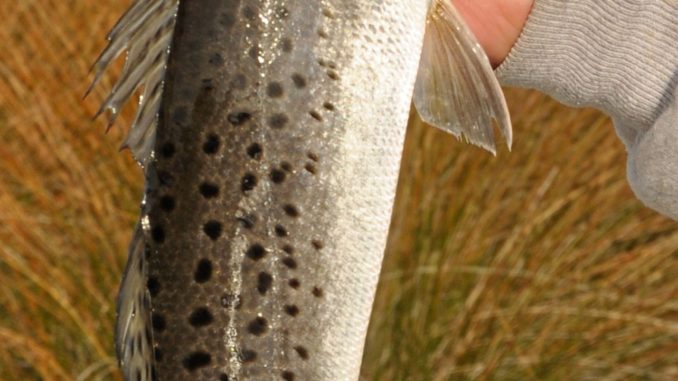
Tributaries to Onslow County’s New River hold some of North Carolina’s biggest speckled trout. Here’s how to catch them.
Guide Ricky Kellum of Jacksonville laughs when he recalls certain phone calls he receives each spring.
“Some people ask me, ‘When will the 10-pounders start biting?'” Kellum said, chuckling.
The “10-pounders” anglers want information about are New River spotted seatrout.
“I tell them the same thing – there are 10-pounders out there, but about the only way I can guarantee they’ll catch one is if they’re willing to book a trip with me every day,” Kellum said.
Few saltwater fishing guides – even in Florida or Louisiana – would be willing to guarantee even that kind of nebulous offer, because 10-pound speckled trout may be the rarest of coastal inshore fish, especially in the Tarheel State. But the New River and its feeder streams have a reputation for cranking out trophy-size specks. Each year, fishermen catch a handful of well-publicized, double-digit trout.
And over the past two years, spotted seatrout have been plentiful along the North Carolina coast because the region hasn’t suffered through prolonged sub-freezing spells that often stun and kill trout. And for whatever reason, New River waters usually avoid ice and winter temperatures that are lethal for trout.
Kellum also knows there’s always an outside chance while fishing the tributary creeks of the river that he or a client will hook up with a fish that’ll reach or surpass 10 pounds. For several reasons, the river produces the largest specks in the state’s inshore waters, and April is a particularly good time to catch the “gators.”
During April, the waters of the river – the state’s only one of its length (50 miles) and size that originates and ends in one county (Onslow) — warm up enough to activate the metabolisms of all kinds of fish. Baitfish seem to come alive, which further invigorates specks.
However, water temperatures in the main river may not be quite high enough to pull trout out of the creeks where they winter. By favoring the shallow waters of its main tributaries, New River specks gather in places where lures and baits can be presented to them in relatively small areas, and that makes them easier targets before they disperse into the river for the summer.
“The favorite food of trout is live shrimp,” said Kellum, who operates Speckled Specialist Inshore Fishing Charters. “I’ll use live shrimp – if I have them – when I want to make sure my clients catch some fish,”
Although he prefers to cast artificial lures, Kellum often uses live shrimp when he has novices on board. In the past, he and his older brother, Randy, a manager of a building-supply store in Greensboro, have used live shrimp to good advantage in several tournaments.
“We won the Swansboro trout tournament five times, including the first two years, with live shrimp under popping corks,” Kellum said. “The first tournament, (Randy) caught a 9-pounder, and I caught a 7-pounder, so we had 16 pounds in the boat after only two fish. The third year, when we didn’t win, the other contestants applauded. There was a little grumbling after we won the first two years.”
Randy Kellum said his competitive brother, “had to go out and catch a 10-pounder to beat my 9-pounder, which he did a few days later.”
Several theories exist as to why the New River produces larger spotted seatrout than any of North Carolina’s other coastal venues.
One is that relatively shallow water allows sunlight to penetrate to the bottom most of the year, which keeps the temperature higher, especially during winter. This tendency to have warmer water than in other areas draws baitfish, and gamefish such as trout follow. The river’s waters also remain relatively warm, which prevents winter freezes.
Once the water temperature rises during early spring, even if a late-season cold snap occurs, it usually doesn’t last for a long time – at least not long enough to drop the water temperature precipitously.
Additionally, the New River’s major feeder streams —Southwest, Frenchs, Northeast, Duck, Wallace, Lewis and Town creeks, are protected from chilly north, northeast and west winds.
“The creeks in the New River have baitfish in them all-year long,” Kellum said. “I think that’s why people have so much success for specks, even when it’s cold. And I think it also may be the reason the specks grow so large — there’s plenty of baitfish to eat year-round, and because of the warm, shallow water there’s plenty of places for baitfish and specks to hide.”
One of the major structures that holds trout — the Sneads Ferry Bridge — has de facto protection from netting, Kellum said.
“The bottom is too deep, and there are too many snags for people to use nets,” he said. “People net a lot of specks from the river and creeks, but nets get torn up or snagged if they use them near the bridge.”
It was 1973, near the bridge, when Kellum’s father, Rendel Kellum, landed a trout that took over the state-record slot, a 31-inch specimen that weighed 11 pounds, 10 ounces. The record stood for several years before a 12-pound, 4-ounce trout from the Wilmington area took over the top spot.
“April and May will be good months at the bridge, because the water will warm up and trout can feed on live shrimp,” he said. “You’ll catch one, and when you get him in the boat, he’ll have a lure in his mouth and still spitting up shrimp.”
If Kellum is lucky enough to catch a trophy trout, he’ll take photos, then return the trophy fish to the water.
“I like to eat trout as much as the next guy, but I only keep smaller fish to eat,” he said. “I put big ones back in the river, mainly because little ones taste better, I think, and the big trout usually are females you want to have a chance to lay their eggs.”
Although Kellum’s father landed his record trout along the shoreline of the main river near the bridge, most April specks will be concentrated in the river’s major feeder creeks.
“I like to fish Southwest and Frenchs in April,” Kellum said. “Northeast is good, too, but I don’t fish there as much as the other two.
“The majority of trout will range from one to six pounds, but there’s always the possibility you can catch a bigger one. It’s not like fishing the inlets (Bear and Browns) where you can catch a ton of fish, but they’ll mostly be ‘spikes’ (small, non-keeper fish).”
Kellum said patience is important in spring fishing for trout in feeder creeks.
“When you go to a creek, they might not bite to start the day, but they’ll turn on some time,” he said. “You just have to be there fishing for them.”
Kellum spends a good amount of his April fishing time at Southwest Creek, which forms the southern boundary of New River Marine Corps Air Station, because he loves topwater fishing for specks.
“Southwest Creek will be a place where you can catch trout on topwater lures in April,” he said. “To me, that’s the most fun, seeing a trout blow up on a topwater.”
He fishes Zara Spooks, Zara Puppies, Rapala Skitterwalks and MirrOlure MR 17s in mullet colors at specks when the topwater bite is active.
Another of his favorite hard-plastic lures is a 1 1/2-inch Rat-L-Trap with a green top and silver sides, but as much as he prefers to catch trout on topwater lures, the majority of the time, Kellum will fish sinking, soft-plastic lures. He prefers to fish artificial shrimp and catches around 80 percent of his specks on some type of shrimp-imitator lure.
“The best shrimp lures for April are 4-inch Billy Bay Halo Shrimp, if I’m fishing the river,” he said. “That’s my river bait.”
He likes clear colors with metal flake, and he dips the tails in chartreuse, pink or red Spike-It dip dye.
“That color change seems to help draw some drum strikes, too,” said Kellum, who smaller (3- to 3 1/2-inch) soft-plastic shrimp lures — Storm and Gulp! shrimp and Jerkshad — when fishing feeder creeks instead of the main river.
But using soft-plastic shrimp lures isn’t easy. It takes skill to work them properly in order to draw strikes.
“When you cast out this lure, you’ve got to let it go all the way to the bottom,” Kellum said. “Then, you make a sharp ‘pop’ (with) the rod tip to lift the lure off the bottom, and then let the lure fall. (Trout) will always hit this lure on the fall.”
The key to detecting strikes is to keep the line taught even as the lure falls, so the angler can see the twitch when a trout strikes or see the line begin to move, which means a trout has picked up the lure.
“Most people reel in their lures too fast, don’t pop them off the bottom and don’t look for the line to move,” Kellum said.
The same technique works in January, February and March, although the process must be slowed drastically because trout are lethargic when water temperatures are in the 40s.
“When April comes and the water temperature is higher, trout become more active, so you don’t have to work the lures as slow, and fish will come after lures a lot more aggressively,” Kellum said.
DESTINATION INFORMATION
HOW TO GET THERE/WHEN TO GO: From north and south, follow US 17 to Jacksonville. From the central part of the state, the best route is to follow I-40 toward Wilmington, exiting on NC 24 to Jacksonville. NC 24 and US 17 cross the New River. April is a great month to catch speckled trout in the river’s tributary creeks before they get in the main river and spread out.
TACKLE/LURES: Seven-foot spinning outfits spooled with 10-pound braid and two feet of 20-pound fluorocarbon leader connected by a Uni-Knot. MirrOlures, Zara Spooks and Pups, Skitterwalks and 3-inch artificial shrimp, such as Billy Bay Halo, D.O.A. and Gulp! Some anglers like curlytail and paddletails fished on jigheads.
GUIDES/FISHING INFO: Ricky Kellum, Speckled Specialist Inshore Fishing Charters, 910-330-2745, www.speckledspecialist.com. See also Guides and Charters in Classifieds.
ACCOMMODATIONS: Onslow County Tourism, Jacksonville, 800-932-2144, www.onslowcountytourism.com.
MAPS: GMCO’s Chartbook of North Carolina, 888-420-6277, www.gmcomaps.com; Sealake Fishing; Guides, 800-411-0185, www.thegoodspots.com.

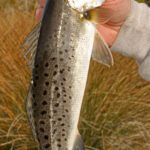
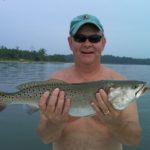
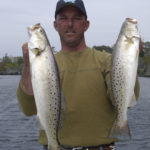
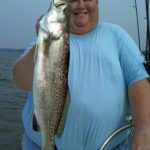
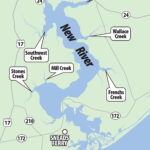

Be the first to comment